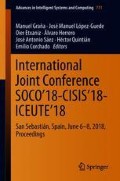Abstract
Positioning accuracy of servo drive systems is very important for tasks that require precision. From the control point of view, servo drive systems are complex due to their non-linear time-varying dynamics. Most of the control strategies applied to these systems either introduce undesirable chattering in the response or suppress it at the cost of producing large tracking errors. In this work, an equivalent sliding mode control based on fuzzy logic is applied to a servo system. The fuzzy membership functions of the switching function are optimized in order to improve the control robustness and to obtain accurate tracking at the same time. Simulation results show that this soft computing control proposal can effectively eliminate the chattering and reduce the tracking error for servo drive systems. It has been compared to conventional sliding mode control and sliding mode control with boundary layer with encouraging results.
Access this chapter
Tax calculation will be finalised at checkout
Purchases are for personal use only
References
Zhang, Z., Yan, P., Hao, G.: A large range flexure-based servo system supporting precision additive manufacturing. Engineering 3(5), 708–715 (2017)
Lee, H., Utkin, V.I.: Chattering suppression methods in sliding mode control systems. Annu. Rev. Control 31(2), 179–188 (2007)
Sumantri, B., Uchiyama, N., Sano, S.: Least square based sliding mode control for a quad-rotor helicopter and energy saving by chattering reduction. Mech. Syst. Signal Process. 66, 769–784 (2016)
Liu, X., Shan, Z., Li, Y.: Dynamic boundary layer based neural network quasi-sliding mode control for soft touching down on asteroid. Adv. Space Res. 59(8), 2173–2185 (2017)
Gao, F., Pan, C., Han, Y.: Design and analysis of a new AUV’s sliding control system based on dynamic boundary layer. Chin. J. Mech. Eng. 26(1), 35–45 (2013)
Chen, M., Yu, J.: Disturbance observer-based adaptive sliding mode control for near-space vehicles. Nonlinear Dyn. 82(4), 1671–1682 (2015)
Farhane, N., Boumhidi, I., Boumhidi, J.: Smart algorithms to control a variable speed wind turbine. Int. J. Interact. Multimedia Artif. Intell. 4(6), 88–95 (2017)
Xu, B., Shi, G., Ji, W., Liu, F., Ding, S., Zhu, H.: Design of an adaptive nonsingular terminal sliding model control method for a bearingless permanent magnet synchronous motor. Trans. Inst. Meas. Control 39(12), 1821–1828 (2017)
Joo, Y.H., Tien, L.Q., Duong, P.X.: Adaptive neural network second-order sliding mode control of dual arm robots. Int. J. Control Autom. Syst. 15(6), 2883–2891 (2017)
Yu, J., Liu, J., Wu, Z., Fang, H.: Depth control of a bioinspired robotic dolphin based on sliding-mode fuzzy control method. IEEE Trans. Industr. Electron. 65(3), 2429–2438 (2018)
Nagarale, R.M., Patre, B.M.: Composite fuzzy sliding mode control of nonlinear singularly perturbed systems. ISA Trans. 53(3), 679–689 (2014)
Yoshimura, T.: Design of adaptive fuzzy backstepping sliding mode control for MIMO uncertain discrete-time nonlinear systems based on noisy measurements. J. Vib. Control 24(2), 393–406 (2018)
Lin, Y., Liping, F.: The equivalent sliding mode control based on fuzzy control for an electrical servo system. In: Proceedings of the 27th IEEE Chinese Control Conference, CCC 2008, Kunming, Yunnan, pp. 118–121 (2008)
Wang, J.W., Wu, Z.S.: Mechanical Engineering Control Foundation, 2nd edn. Higher Education Press, Beijing (2010)
Liu, J.K.: Matlab simulation for sliding model control. Tsinghua University Press, Beijing (2005)
Slotine, J.J., Sastry, S.S.: Tracking control of non-linear systems using sliding surfaces, with application to robot manipulators. Int. J. Control 38(2), 465–492 (1983)
Zhao, W.J., Liu, J.Z.: An improved method of sliding mode control with boundary layer. Acta Simulata Systematica Sinica 17(1), 156–158 (2005)
Santos, M.: An applied approach of intelligent control. Revista Iberoamericana de Automática e Informática Ind. RIAI 8(4), 283–296 (2011)
Author information
Authors and Affiliations
Corresponding author
Editor information
Editors and Affiliations
Rights and permissions
Copyright information
© 2019 Springer International Publishing AG, part of Springer Nature
About this paper
Cite this paper
Zhang, Z., Santos, M. (2019). Optimizing a Fuzzy Equivalent Sliding Mode Control Applied to Servo Drive Systems. In: Graña, M., et al. International Joint Conference SOCO’18-CISIS’18-ICEUTE’18. SOCO’18-CISIS’18-ICEUTE’18 2018. Advances in Intelligent Systems and Computing, vol 771. Springer, Cham. https://doi.org/10.1007/978-3-319-94120-2_29
Download citation
DOI: https://doi.org/10.1007/978-3-319-94120-2_29
Published:
Publisher Name: Springer, Cham
Print ISBN: 978-3-319-94119-6
Online ISBN: 978-3-319-94120-2
eBook Packages: Intelligent Technologies and RoboticsIntelligent Technologies and Robotics (R0)

